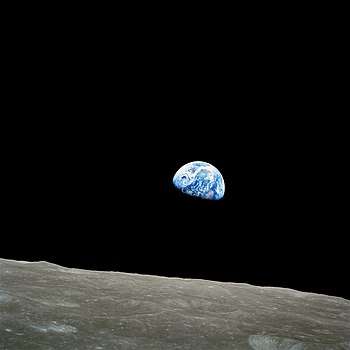Christmas Eve
Christmas Eve is the evening or entire day before Christmas Day, the festival commemorating the birth of Jesus.[4] Christmas Day is observed around the world, and Christmas Eve is widely observed as a full or partial holiday in anticipation of Christmas Day. Together, both days are considered one of the most culturally significant celebrations in Christendom and Western society.
| Christmas Eve | |
|---|---|
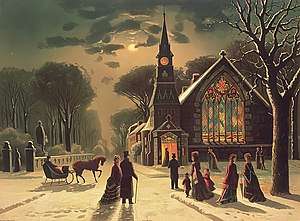 Christmas Eve, an 1878 painting by J. Hoover & Son | |
| Also called | Christmas Evening Christmas Vigil Day before Christmas Night before Christmas |
| Observed by | Christians Many non-Christians[1] |
| Type | Christian, cultural |
| Significance | Day or evening preceding the traditional birthday of Jesus |
| Observances | Gift shopping, gift giving, goodwill greetings, Midnight Mass, other church services, meals, preparations for the arrival of Christmas gift-bringers, preparing for Christmas |
| Date |
|
| Frequency | Annual |
| Related to | Christmas Day, Christmastide, New Year's Eve |
Christmas celebrations in the denominations of Western Christianity have long begun on Christmas Eve, due in part to the Christian liturgical day starting at sunset,[5] a practice inherited from Jewish tradition[6] and based on the story of Creation in the Book of Genesis: "And there was evening, and there was morning – the first day."[7] Many churches still ring their church bells and hold prayers in the evening; for example, the Nordic Lutheran churches.[8] Since tradition holds that Jesus was born at night (based in Luke 2:6-8), Midnight Mass is celebrated on Christmas Eve, traditionally at midnight, in commemoration of his birth.[9] The idea of Jesus being born at night is reflected in the fact that Christmas Eve is referred to as Heilige Nacht (Holy Night) in German, Nochebuena (the Good Night) in Spanish and similarly in other expressions of Christmas spirituality, such as the song "Silent Night, Holy Night".
Many other varying cultural traditions and experiences are also associated with Christmas Eve around the world, including the gathering of family and friends, the singing of Christmas carols, the illumination and enjoyment of Christmas lights, trees, and other decorations, the wrapping, exchange and opening of gifts, and general preparation for Christmas Day. Legendary Christmas gift-bearing figures including Santa Claus, Father Christmas, Christkind, and Saint Nicholas are also often said to depart for their annual journey to deliver presents to children around the world on Christmas Eve, although until the Protestant introduction of Christkind in 16th-century Europe,[10] such figures were said to instead deliver presents on the eve of Saint Nicholas' feast day (6 December).
Religious traditions
Western churches
.jpg)
Roman Catholics and high church Anglicans traditionally celebrate Midnight Mass, which begins either at or sometime before midnight on Christmas Eve. This ceremony, which is held in churches throughout the world, celebrates the birth of Christ, which is believed to have occurred at night. Midnight Mass is popular in Poland (pasterka) and Lithuania (piemenėlių mišios).
In recent years some churches have scheduled their "Midnight" Mass as early as 7 pm. This better suits the young children, whose choral singing has become a popular feature in some traditions. In Spanish-speaking areas, the Midnight Mass is sometimes referred to as Misa de Gallo, or Missa do Galo in Portuguese ("Rooster's Mass"). In the Philippines, the custom has expanded into the nine-day Simbang Gabi, when Filipinos attend dawn Masses (traditionally beginning around 04:00 to 05:00 PST) from 16 December, continuing daily until Christmas Eve. In 2009 Vatican officials scheduled the Midnight Mass to start at 10 pm so that the 82-year-old Pope Benedict XVI would not have too late a night.[11]
A nativity scene may be erected indoors or outdoors, and is composed of figurines depicting the infant Jesus resting in a manger, Mary, and Joseph.[12] Other figures in the scene may include angels, shepherds, and various animals. The figures may be made of any material,[13] and arranged in a stable or grotto. The Magi may also appear, and are sometimes not placed in the scene until the week following Christmas to account for their travel time to Bethlehem. While most home nativity scenes are packed away at Christmas or shortly thereafter, nativity scenes in churches usually remain on display until the feast of the Baptism of the Lord.[13]
Whilst it does not include any kind of Mass, the Church of Scotland has a service beginning just before midnight, in which carols are sung. The Church of Scotland no longer holds Hogmanay services on New Year's Eve, however. The Christmas Eve Services are still very popular. On Christmas Eve, the Christ Candle in the center of the Advent wreath is traditionally lit in many church services. In candlelight services, while singing Silent Night, each member of the congregation receives a candle and passes along their flame which is first received from the Christ Candle.
Lutherans traditionally practice Christmas Eve Eucharistic traditions typical of Germany and Scandinavia. "Krippenspiele" (Nativity plays), special festive music for organ, vocal and brass choirs and candlelight services make Christmas Eve one of the highlights in the Lutheran Church calendar.
Christmas Vespers are popular in the early evening, and midnight services are also widespread in regions which are predominantly Lutheran. The old Lutheran tradition of a Christmas Vigil in the early morning hours of Christmas Day (Christmette) can still be found in some regions. In eastern and middle Germany, congregations still continue the tradition of "Quempas singing": separate groups dispersed in various parts of the church sing verses of the song "He whom shepherds once came Praising" (Quem pastores laudavere) responsively.
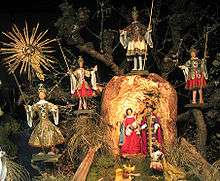
Methodists celebrate the evening in different ways. Some, in the early evening, come to their church to celebrate Holy Communion with their families. The mood is very solemn, and the only visible light is the Advent Wreath, and the candles upon the Lord's Table. Others celebrate the evening with services of light, which include singing the song Silent Night as a variety of candles (including personal candles) are lit. Other churches have late evening services perhaps at 11 pm, so that the church can celebrate Christmas Day together with the ringing of bells at midnight. Others offer Christmas Day services as well.
The annual "Nine Lessons and Carols", broadcast from King's College, Cambridge on Christmas Eve, has established itself a Christmas custom in the United Kingdom.[14] It is broadcast outside the UK via the BBC World Service, and is also bought by broadcasters around the world.[14]
Eastern churches
In the Byzantine Rite, Christmas Eve is referred to as Paramony ("preparation"). It is the concluding day of the Nativity Fast and is observed as a day of strict fasting by those devout Byzantine Christians who are physically capable of doing so. In some traditions, nothing is eaten until the first star appears in the evening sky, in commemoration of the Star of Bethlehem. The liturgical celebration begins earlier in the day with the celebration of the Royal Hours, followed by the Divine Liturgy combined with the celebration of Vespers, during which a large number of passages from the Old Testament are chanted, recounting the history of salvation. After the dismissal at the end of the service, a new candle is brought out into the center of the church and lit, and all gather round and sing the Troparion and Kontakion of the Feast.
In the evening, the All-Night Vigil for the Feast of the Nativity is composed of Great Compline, Matins and the First Hour. The Byzantine services of Christmas Eve are intentionally parallel to those of Good Friday, illustrating the theological point that the purpose of the Incarnation was to make possible the Crucifixion and Resurrection. This is illustrated in Eastern icons of the Nativity, on which the Christ Child is wrapped in swaddling clothes reminiscent of his burial wrappings. The child is also shown lying on a stone, representing the Tomb of Christ, rather than a manger. The Cave of the Nativity is also a reminder of the cave in which Jesus was buried.
The services of Christmas Eve are also similar to those of the Eve of Theophany (Epiphany), and the two Great Feasts are considered one celebration.
In some Orthodox cultures, after the Vesperal Liturgy the family returns home to a festive meal, but one at which Orthodox fasting rules are still observed: no meat or dairy products (milk, cheese, eggs, etc.) are consumed (see below for variations according to nationality). Then they return to the church for the All-Night Vigil.
The next morning, Christmas Day, the Divine Liturgy is celebrated again, but with special features that occur only on Great Feasts of the Lord. After the dismissal of this Liturgy, the faithful customarily greet each other with the kiss of peace and the words: "Christ is Born!", to which the one being greeted responds: "Glorify Him!" (the opening words of the Canon of the Nativity that was chanted the night before during the Vigil). This greeting, together with many of the hymns of the feast, continue to be used until the leave-taking of the feast on 29 December.
The first three days of the feast are particularly solemn. The second day is known as the Synaxis of the Theotokos, and commemorates the role of the Virgin Mary in the Nativity of Jesus. The third day is referred to simply as "the Third Day of the Nativity". The Saturday and Sunday following 25 December have special Epistle and Gospel readings assigned to them. 29 December celebrates the Holy Innocents.
Byzantine Christians observe a festal period of twelve days, during which no one in the Church fasts, even on Wednesdays and Fridays, which are normal fasting days throughout the rest of the year. During this time one feast leads into another: 25–31 December is the afterfeast of the Nativity; 2–5 January is the forefeast of the Epiphany.
Meals
Bulgaria
In Bulgaria, the meal consists of an odd number of lenten dishes in compliance with the rules of fasting. They are usually the traditional sarma, bob chorba (bean soup), fortune kravai (pastry with a fortune in it; also called bogovitsa, vechernik, kolednik), stuffed peppers, nuts, dried fruit, boiled wheat.[15] The meal is often accompanied with wine or Bulgaria's traditional alcoholic beverage rakia, in the past olovina (a type of homemade rye beer). The meals used to be put on top of hay, directly on the floor, together with a ploughshare or a coulter.[16]
France
In French-speaking places, Réveillon is a long dinner eaten on Christmas Eve.
Italy
While other Christian families throughout the world celebrate the Christmas Eve meal with various meats, Italians (especially Sicilians) celebrate the traditional Catholic "Feast of the Seven Fishes" which was historically served after a 24-hour fasting period. Although Christmas fasting is no longer a popular custom, some Italian-Americans still enjoy a meatless Christmas Eve feast[17] and attend the Midnight Mass. In various cultures, a festive dinner is traditionally served for the family and close friends in attendance, when the first star (usually Sirius) arrives on the sky.
Poland
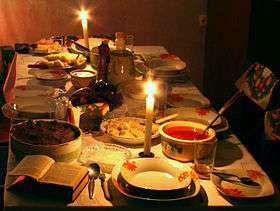
A similar tradition (Wigilia, or 'Christmas Vigil') exists in Poland. The number of dishes used to be traditionally an odd number (usually 5, 7, 9, or 11.)[18] According to the Słownik etymologiczny języka polskiego (Etymological Dictionary of the Polish Language) by Aleksander Brückner, the number of dishes was traditionally related to social class: the peasants' vigil consisted of 5 or 7 dishes, the gentry usually had 9, and the aristocracy, 11 dishes, but the even number 12 is also found today to remember the 12 disciples. It is obligatory to try a portion of all of them. Some traditions specify that the number of guests cannot be odd.[19][20]
In Poland, gifts are unwrapped on the Christmas Eve, as opposed to the Christmas Day.
Lithuania
Lithuanian Christmas Eve blends pagan and Christian traditions as initially it was a celebration of winter solstice.[21] Traditionally, Lithuanians believed that animals could talk on that night, and it was possible to predict the future.[22] Kūčios ("Holy Meal") is the most important event of the year and family reunion. Dead relatives are remembered with an empty plate set at the table.[23] The feast starts after the rise of the evening star.[24] No products made from meat, milk and alcohol are allowed during the Kūčios.[25] In all, 12 dishes are served, all of them rustic, made from grains, fish, dried fruit or mushrooms including kūčiukai. Small biscuits soaked in poppy seed milk are served. After the dinner is over the table is left uncleared overnight for the feast of vėlės (spirits or soul).[26][27]
Russia, Ukraine
In Russia, Ukraine, traditional, meatless, 12-dishes Christmas Eve Supper is served on Christmas Eve before opening gifts. The table is spread with a white cloth symbolic of the swaddling clothes the Child Jesus was wrapped in, and a large white candle stands in the center of the table symbolizing Christ the Light of the World. Next to it is a round loaf of bread symbolizing Christ Bread of Life. Hay is often displayed either on the table or as a decoration in the room, reminiscent of the manger in Bethlehem. The twelve dishes (which differ by nationality or region) symbolize the Twelve Apostles.
The Holy Meal was a common Eastern Orthodox tradition in the Russian Empire, but during the era of the Soviet Union it was greatly discouraged as a result of the official atheism of the former regime. It is coming back in Russia and continues to be popular in Ukraine.
The main attributes of Holy Meal in Ukraine are kutia, a poppy seed, honey and wheat dish, and uzvar, a drink made from reconstituted dried fruits. Other typical dishes are borscht, Varenyky, and dishes made of fish, phaseolus and cabbage.
Serbia
In accordance with the Christmas traditions of the Serbs, their festive meal has a copious and diverse selection of foods, although it is prepared according to the rules of fasting.
As well as a round, unleavened loaf of bread and salt, which are necessary, this meal may comprise roast fish, cooked beans, sauerkraut, noodles with ground walnuts, honey, and wine.
Families in some Slavic countries leave an empty place at the table for guests (alluding to Mary and Joseph looking for shelter in Bethlehem).
Gift giving
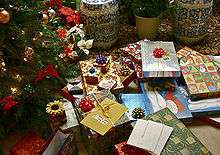
During the Reformation in 16th- and 17th-century Europe, many Protestants changed the gift bringer to the Christ Child or Christkindl, and the date of giving gifts changed from 6 December to Christmas Eve.[28] It is the night when Santa Claus makes his rounds delivering gifts to good children. Many trace the custom of giving gifts to the Magi who brought gifts for the Christ child in the manger.
In the Czech Republic, Slovakia, Croatia and Hungary, where Saint Nicholas (sv. Mikuláš/szent Mikulás) gives his sweet gifts on 6 December, the Christmas gift-giver is the Child Jesus (Ježíšek in Czech, Jézuska in Hungarian, Ježiško in Slovak and Isusek in Croatian).[29]
In most parts of Austria, Germany, Poland, Hungary, Czech Republic and Switzerland, presents are traditionally exchanged on the evening of 24 December. Children are commonly told that presents were brought either by the Christkind (German for Christ child),[30] or by the Weihnachtsmann. Both leave the gifts, but are in most families not seen doing so. In Germany, the gifts are also brought on 6 December by "the Nikolaus" with his helper Knecht Ruprecht.
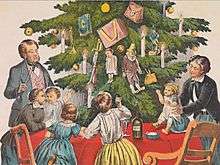
In Estonia Jõuluvana, Finland Joulupukki, Denmark Julemanden, Norway Julenissen and Sweden Jultomten, personally meets children and gives presents in the evening of Christmas Eve.[31][32]
In Argentina, Austria, Brazil, Bulgaria, Colombia, Denmark, Estonia, the Faroe Islands, Finland, France, Germany, Hungary, Slovakia, Iceland, Latvia, Lithuania, Luxembourg, Norway, Poland, Portugal, Quebec, Romania, Uruguay, Slovenia, Sweden, Switzerland and the Czech Republic, Christmas presents are opened mostly on the evening of the 24th – following German tradition, this is also the practice among the British Royal Family since it was introduced by Queen Victoria and Albert, Prince Consort[33][34] – while in Italy, the United States, the United Kingdom, Republic of Ireland, English Canada, South Africa, New Zealand and Australia, this occurs mostly on the morning of Christmas Day.
In other Latin American countries, people stay awake until midnight, when they open the presents.
In Spain, gifts are traditionally opened on the morning of 6 January, Epiphany day ("Día de Los Tres Reyes Magos"),[35] though in some other countries, like Mexico, Argentina and Uruguay, people receive presents both around Christmas and on the morning of Epiphany day.
In Belgium and the Netherlands Saint Nicholas or Sinterklaas and his companion Zwarte Piet deliver presents to children and adults alike on the evening of 5 December, the eve of his nameday.[36] On 24 December they go to church or watch the late-night Mass on TV, or have a meal.
Christmas Eve around the world
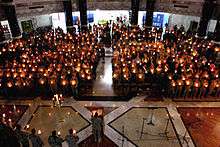
Christmas Eve is celebrated in different ways around the world, varying by country and region. Elements common to many areas of the world include the attendance of special religious observances such as a midnight Mass or Vespers and the giving and receiving of presents. Along with Easter, Christmastime is one of the most important periods on the Christian calendar, and is often closely connected to other holidays at this time of year, such as Advent, the Feast of the Immaculate Conception, St. Nicholas Day, St. Stephen's Day, New Year's, and the Feast of the Epiphany.
Celebrations
Among Christians, as well as non-Christians who celebrate Christmas, the significant amount of vacation travel, and travel back to family homes, that takes place in the lead-up to Christmas means that Christmas Eve is also frequently a time of social events and parties, worldwide.[37][38][39][40][41]
In Jewish culture
Nittel Nacht is a name given to Christmas Eve by Jewish scholars in the 17th century.
In contemporary American-Jewish culture
With Christmas Day a work holiday throughout the United States, there is a space of unfilled free time during which much of American commerce and society is not functioning, and which can give rise to a sense of loneliness or alienation for American Jews.[42][43][44][45][46]
Jews also typically do not engage in the family gathering and religious worship activities that are central to Christmas Eve for Christians.[47]
Typical contemporary activities have usually been limited to "Chinese and a movie"[48][49][50]—consuming a meal at a Chinese restaurant, which tend to be open for business on the Christmas holiday, and watching a movie at the theater or at home, stereotypically a rerun of It's a Wonderful Life.[46][51][52][53]
Since the 1980s a variety of social events for young Jews have sprung up, and become popular, on Christmas Eve.[54] These include the Matzo Ball, The Ball, and a number of local events organized by Jewish communities and local Jewish Federations in North America.[43]
In Chinese culture
In Mandarin, Christmas Eve is called 平安夜 ("peaceful night"). People exchange apples, because the word for "apple" (
Historical events
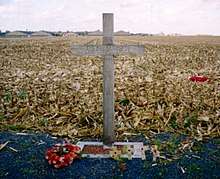
A number of historical events have been influenced by the occurrence of Christmas Eve.
Christmas truce
During World War I in 1914 and 1915 there was an unofficial Christmas truce, particularly between British and German troops. The truce began on Christmas Eve, 24 December 1914, when German troops began decorating the area around their trenches in the region of Ypres, Belgium, for Christmas. They began by placing candles on trees, then continued the celebration by singing Christmas carols, most notably Stille Nacht ("Silent Night"). The British troops in the trenches across from them responded by singing English carols. The two sides shouted Christmas greetings to each other. Soon there were calls for visits across the "No man's land" when small gifts were exchanged. The truce also allowed a breathing space during which recently killed soldiers could be brought back behind their lines by burial parties. Funerals took place as soldiers from both sides mourned the dead together and paid their respects. At one funeral in No Man's Land, soldiers from both sides gathered and read a passage from Psalm 23. The truce occurred in spite of opposition at higher levels of the military command. Earlier in the autumn, a call by Pope Benedict XV for an official truce between the warring governments had been ignored.
Apollo 8 reading from Genesis
On 24 December 1968, in what was the most watched television broadcast to that date, the astronauts Bill Anders, Jim Lovell and Frank Borman of Apollo 8 surprised the world with a reading of the Creation from the Book of Genesis as they orbited the Moon.[56] Madalyn Murray O'Hair, an atheist activist, filed a lawsuit under the Establishment Clause of the First Amendment.[57] The trial court dismissed the lawsuit, which was upheld on appeal.[58]
In 1969, the United States Postal Service issued a stamp (Scott# 1371) commemorating the Apollo 8 flight around the Moon. The stamp featured a detail of the famous photograph, Earthrise, of the Earth "rising" over the Moon (NASA image AS8-14-2383HR), taken by Anders on Christmas Eve, and the words, "In the beginning God...".
See also
- Christmas Day
- Nativity of Jesus
- Santa Claus
- Winter holiday season
References
- Christmas as a Multi-faith Festival—BBC News. Retrieved 24 November 2011.
- "Christmas is here- yet again!The Holy Land is unique in celebrating Christmas three times; on December 25th, January 6th and January 19th". JPost.
- Ramzy, John. "The Glorious Feast of Nativity:? 29 Kiahk? 25 December?". Coptic Orthodox Church Network. Retrieved 17 January 2011.
- Mary Pat Fisher (1997). Living Religions: an encyclopedia of the world's faiths. I.B.Tauris. ISBN 9781860641480. Archived from the original on 29 October 2013. Retrieved 29 December 2010.
Christmas is the celebration of Jesus' birth on earth.
- "Christian Calendar". Jerusalem Center for Jewish-Christian Relations. Archived from the original on 23 July 2011. Retrieved 29 December 2010.
- Kessler, Edward; Neil Wenborn (2005). A dictionary of Jewish-Christian relations. Cambridge, Cambridgeshire, United Kingdom: Cambridge university Press. p. 274.
- Bible - NIV. 2005.
- "Helgmålsringning". Natinalencyclopedin. Retrieved 29 December 2010.
- "Vatican Today". Retrieved 29 December 2010.
- Forbes, Bruce David, Christmas: a candid history, University of California Press, 2007, ISBN 0-520-25104-0, pp. 68–79.
- "Woman knocks Pope down at Christmas Mass". British Broadcasting Company. 25 December 2009.
- Vermes, Geza. The Nativity: History and Legend. Penguin, 2006
- Dues, Greg.Catholic Customs and Traditions: A Popular Guide Twenty-Third Publications, 2000.
- Alex Webb (24 December 2001), Choir that sings to the world, BBC News
- Bulgarian Main Courses Archived 4 January 2009 at the Wayback Machine
- Христо Вакарелски. Етнография на България. Наука и изкуство. София 1977. с. 500
- "Feast of Seven Fishes – A Sicilian Christmas Eve Tradition". Rachael Ray Digital LLC. 2014. Retrieved 14 November 2014.
Sicilians traditionally celebrate Christmas Eve with a "Feast of Seven Fishes" which was historically served after a 24-hour fasting period. Although pre-Christmas fasting is not a popular custom still practiced by Italian-Americans, many still enjoy a meatless Christmas Eve feast.
- Kasprzyk, Magdalena. "The 12 Dishes of Polish Christmas". Culture.pl. Retrieved 3 August 2016.
- "12, 11, 9? Ile dań na Wigilie? - Święta". polskieradio.pl. 19 December 2010. Retrieved 14 February 2014.
- "Wigilia". Polishcenter.org. Archived from the original on 24 February 2014. Retrieved 14 February 2014.
- Kubilius, Kerry (2017). "Lithuania Christmas Traditions". www.tripsavvy.com. Retrieved 22 December 2018.
In pagan Lithuania, the Christmas celebration as we know it today was actually the celebration of the winter solstice.
- "Lithuania, Christmas in". Retrieved 22 December 2018.
Hundreds of little Christmas Eve formulas and charms offer Lithuanians ways in which to use the events of this evening to predict the future.
- Grinevičiūtė, Monika (December 2018). "Magical Christmas Eve in Lithuania - Kūčios". Retrieved 22 December 2018.
One more important thing - it is believed that during the Christmas Eve all family members are coming together to have dinner. It means the deceased relatives as well, so for that reason on the table one more, additional plate, is always placed.
- "Lithuanian customs and traditions". thelithuanians.com. Archived from the original on 14 February 2019. Retrieved 22 December 2018.
The ritual supper is not eaten until the evening star appears in the sky. Until then, the bathhouse is heated, people bathe and dress up in festive clothes. The floor was strewn with juniper by the mistress and the master placed handfuls of hay on the table, covered it with a white linen tablecloth.
- "2/10/2011 Lithuanian traditions: Christmas". www.lithaz.org. Retrieved 22 December 2018.
The meal served on Christmas Eve did not include meat, milk products or eggs.
- "Lithuanian customs and traditions". thelithuanians.com. Archived from the original on 14 February 2019. Retrieved 22 December 2018.
Most often the "Kūčia" table was not cleared away, for it was believed that when the family is asleep the souls of the dead come in to eat.
- Vaicekauskas, Arūnas (2014). "Ancient Lithuanian Calendar Festivals" (PDF). Vytautas Magnus University. p. 31. Archived from the original (PDF) on 22 July 2017. Retrieved 22 December 2018.
The cult of the dead is well noticed in the custom when, after Christmas Eve supper the table is not cleared but left overnight. It was believed that the souls of the dead would come and serve themselves at night.
- Forbes, Bruce David, Christmas: a candid history, University of California Press, 2007, ISBN 0-520-25104-0, pp. 68–79.
- The Christmas encyclopedia McFarland p.143. & Co., 2005
- The Christmas Almanack p.56. Random House Reference, 2004
- Llewellyn's Sabbats Almanac: Samhain 2010 to Mabon 2011 p.64. Llewellyn Worldwide, 2010
- Festivals of Western Europe p.202. Forgotten Books, 1973
- "Queen Victoria's Christmas - A 'chandelier Christmas tree' and family gifts go on display for the first time". Royal Collection Trust. 30 November 2012. Retrieved 25 December 2016.
- Hoey, Brian (12 December 2014). "How the Royal Family do Christmas". Wales Online. Retrieved 25 December 2016.
- Francis, Charles Wisdom Well Said p.224 Levine Mesa Press, 2009
- Concepts of person in religion and thought Walter de Gruyter, 1990
- Eugene Fodor, Fodor's South 1980: Alabama, Florida, Georgia, Kentucky, Louisiana, 1979, at p. 87, available at Google Books
- Gary Sigley, A Chinese Christmas Story, in Shi-xu, ed., Discourse as Cultural Struggle, 2007, at p. 99, available at Google Books
- Adebayo Oyebade, Culture and Customs of Angola, 2007, at pp. 103, 140, available at Google Books
- See, e.g., GetQd Twas the Night Before Christmas @ Tonic @ Tonic Nightclub Vancouver BC, 2009 Archived 6 November 2009 at the Wayback Machine
- See, e.g., Upcoming.org, The College Night Out, 2009 Archived 18 March 2012 at the Wayback Machine
- "Dec. 24 is time to party at Mazelpalooza, Matzoball". azcentral. Retrieved 16 May 2019.
- Jessica Gresko, "Dec. 24 Becomes Party Night for Jewish Singles", Associated Press (Washington Post), 24 December 2006
- Tracy, Marc (19 December 2013). "Christmas Is the Greatest Jewish Holiday". The New Republic. ISSN 0028-6583. Retrieved 16 May 2019.
- Barbara Lewis, "MatzoBall Detroit: Jewish singles now have their own party on Christmas Eve", Detroit Jewish News, 18 December 2014
- "平安夜美国犹太单身大聚会-英语点津". language.chinadaily.com.cn. Retrieved 16 May 2019.
- Richardson, Brenda Lane (16 December 1987). "Deciding to Celebrate Christmas, or Not". The New York Times. ISSN 0362-4331. Retrieved 16 May 2019.
- Marziah (24 December 2012). "Happy Chinese and a Movie". Wired. ISSN 1059-1028. Retrieved 16 May 2019.
- "The joy of not celebrating Christmas". Jewish Telegraphic Agency. 24 December 2013. Retrieved 16 May 2019.
- "Chinese food and movies: A Christmas tradition". EW.com. Retrieved 16 May 2019.
- Heyman, Marshall (27 December 2010). "'Tis the Season For Matzo Balls". Wall Street Journal. Retrieved 30 December 2018.
- Call, JODI DUCKETT, The Morning. "JEWISH SINGLES MIMGLE CHRISTMAS EVE". themorningcall.com. Retrieved 16 May 2019.
- Gluck, Robert (20 December 2011). "What young Jews do on Christmas Eve". Los Angeles Jewish Journal. Retrieved 30 December 2018.
- "Christmas Eve parties now a Jewish tradition". 24 December 2006. Retrieved 25 December 2017.
- Ren, Yaoti (14 November 2017). "China's love for Christmas apple gifts". Retrieved 26 December 2018.
- "The Apollo 8 Christmas Eve Broadcast". NASA National Space Science Data Center. 25 September 2007. Archived from the original on 19 April 2008. Retrieved 12 April 2008.
- Chaikin, Andrew (1994). A Man On The Moon: The Voyages of the Apollo Astronauts. Viking. pp. 204, 623. ISBN 0-670-81446-6.
- O'Hair v. Paine, 312 F. Supp. 434 (W.D. Tex. 1969), aff'd, 432 F.2d 66 (5th Cir. 1970) (per curiam), cert. denied, 401 U.S. 955 (1971). See also O'Hair v. Paine 397 U.S. 531 (1970) (dismissing direct appeal of trial court order remanding from three-judge panel).
External links


